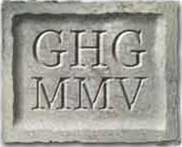
Guarlford History Group
Guarlford's BeginningsEarliest TimesThe story of Guarlford begins when, in Neolithic times, the nearby River Severn was first used as a trade route through the wet lowlands to the east of the Malvern Hills. Rivers such as the Severn provided a way of penetrating the barriers of marsh and woodland for an ancient people who have left little trace of their presence in the area other than a few scattered flint remains, such as a flint axe of Scandinavian origin found at Colwall on the other side of the hills. However, writing in the Malvern News in December 1963, 'Coriander' observes that Guarlford "ůmay be the newest parish in the district, but it is also one of the oldest inhabited places. The Anglo-Saxon tribe of the Hwicce who came up the Severn cleared land between the Rhydd and Poolbrook and had a settlement at the foot of the hills. Before them, some authorities believe ancient Celtic chiefs had a dwelling where Guarlford Court now stands and earlier still there were people who fortified Dripshill during the Iron Age. Their earthworks can be found in the woods that now cover the hill." Guarlford, then, has a history as long as almost any settlement in Britain, though it is still to this day a small village and one with limited documentary and other records. Guarlford lies just beyond the shadow of the Malvern Hills, a little over a mile and a half from Barnards Green to the west and nearly two and a half miles from the foot of the Hills themselves. The dominant geological feature of the Hills, the Malvern Chase which runs down to the Severn at the Rhydd, and the proximity of the Priory Church have together had a shaping influence on Guarlford's story; and the history of the village cannot be recounted without reference to this physical and ecclesiastical landscape. It was the shape of the landscape around Guarlford, which determined the ancient salt way, the links from the Severn at the Rhydd and Clevelode crossings along what is now Rectory Lane to Wood Street and then to Wyche Cutting on the main salt route from Droitwich to South Wales. In July 2004, a hedgerow survey undertaken by Guarlford W.I. indicated that, according to Hooper's Rule, hedges along the boundary of Wood Street are in the region of eight hundred years old; and, in particular, a wild service tree in the hedgerow provides further evidence of great age, since the service tree (Sorbus torminalis) is perhaps lowland England's most reliable 'indicator species' of an ancient woodland or hedgerow habitat. (It should be acknowledged that Hooper's Rule is, of course, a theory and must therefore be treated with some caution.) The present Rectory Lane in Guarlford is part of this prehistoric and then Roman route from the river to the Wyche. The area around Guarlford has yielded evidence of Neolithic (2200-1800 B.C.) movement, and Early, Middle and Late Bronze Age settlement. Iron Age invaders followed, particularly the prominent La Tene culture from about 250 B.C. onwards. There are the defensive banks of an Iron Age hill fort still to be discerned at Dripshill. These earthworks possibly represent the earliest substantial evidence in the local landscape of a settlement which lasted for some time, in this case between 800 B.C. and 42 A.D. the breadth of time meaning that no more precise date can be established on the basis of the available evidence . . .
Hooper's Rule and the Wild Service TreeMax Hooper was an ecologist working for the Institute of Terrestrial Ecology in the 1960s who suggested a strong correlation between the age of a hedge and the number of woody species found in it. 'Hooper's Rule' states that in thirty yards (27.4 metres) of hedge every species represents one century of age. Therefore, a hedge with eight species in thirty yards would be 800 years old. The wild service tree resembles a maple in leaf shape and autumn colouring, but its leaves are alternate and are also similar in shape to a guelder rose or sycamore. The tree's ascending branches form a conical shape when it is young, but broaden into a spreading, domed head with maturity, growing up to 20 metres. Its bark is dark grey with broken shallow fissures. |